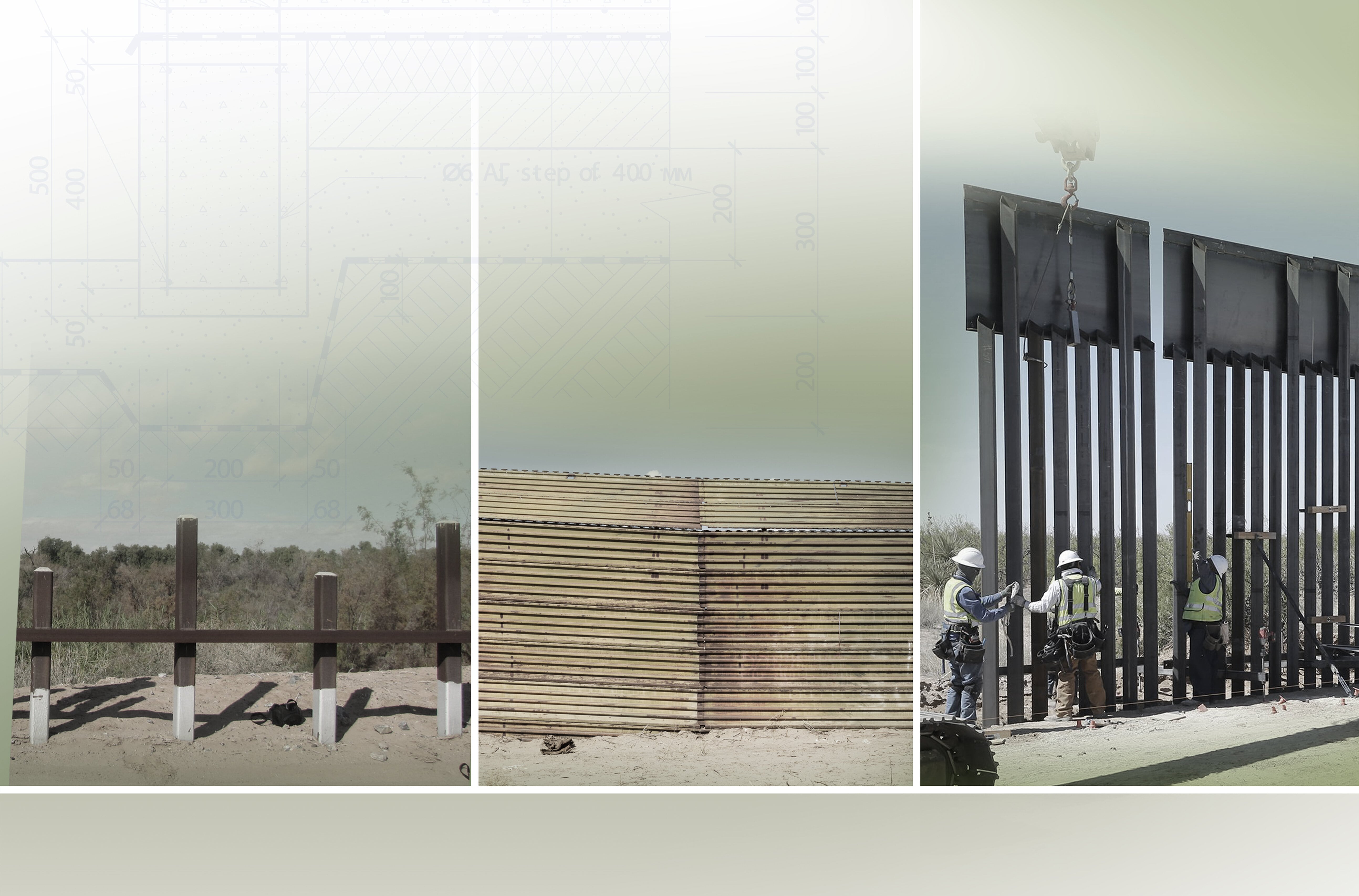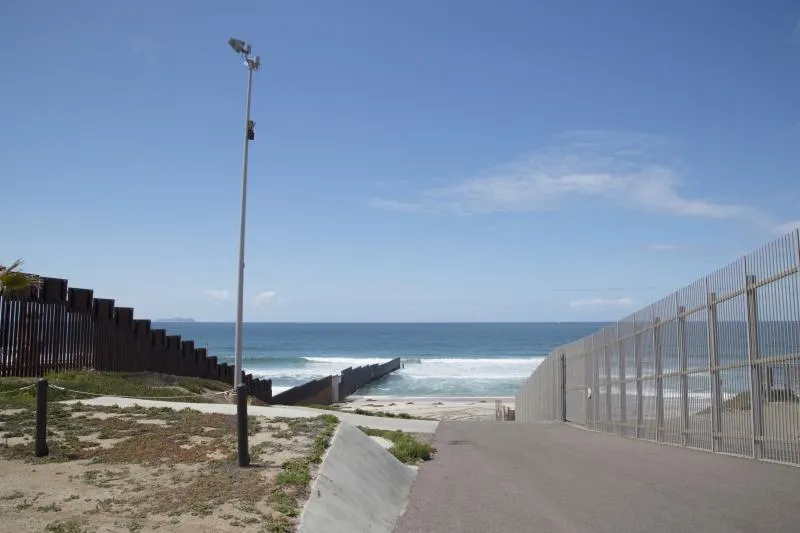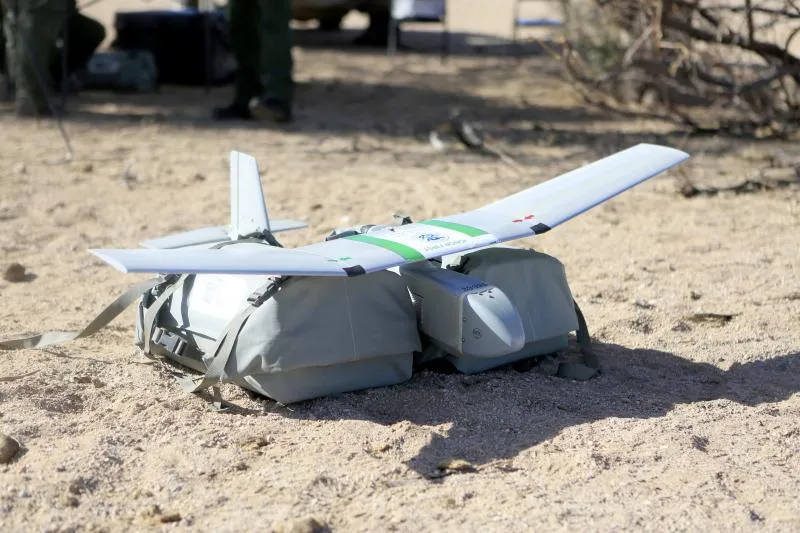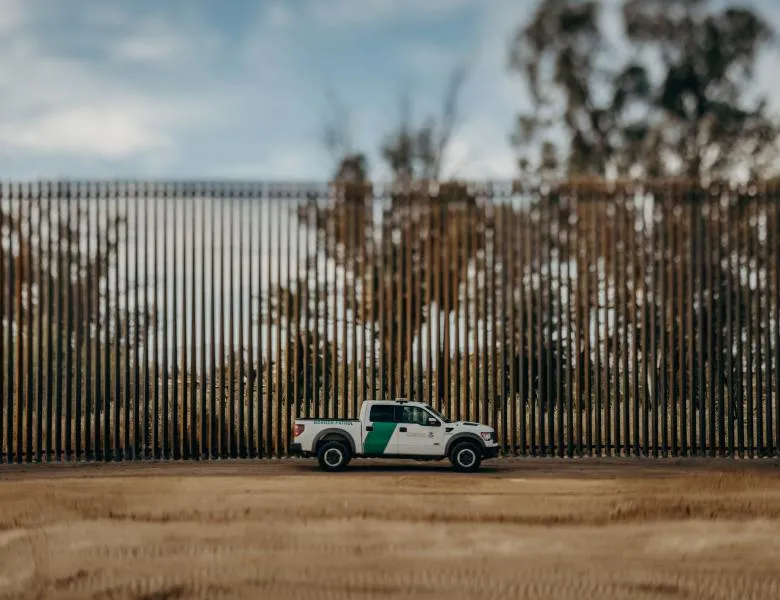
Walls Work

Chief Patrol Agent Rodney Scott remembers the chaos. His first assignment as a new Border Patrol agent in 1992 was along the U.S.-Mexico border near San Diego, a place where thousands of illegal immigrants lined up and rushed the border en masse, their numbers overwhelming the handful of agents trying to stop them.
“On day one when I showed up to work, I saw hundreds of people running up the median of Interstate 5, helicopters buzzing around, and I thought there was some kind of big incident or crisis that day,” Scott said, who now runs the San Diego sector for the U.S. Border Patrol. But he quickly found out it was just a normal day.
Meanwhile, Border Patrol Agent Fidel Baca peers out from the flat expanse of the New Mexico desert along a section of low wall, being met by a new 18-foot tall, steel bollard-style fence replacing the three-foot tall vehicle barrier. While the low barrier was built to keep vehicles from running drugs across the border, it is practically useless in stopping the foot traffic that has increased in recent years.
“This higher barrier will give us more time to react,” Baca said. “The new fence is making it harder for illegal aliens to enter.”
In Arizona, CBP law enforcement personnel are testing the latest technology – such as unmanned aerial vehicles and new radio and surveillance systems – aimed at shoring up the U.S. southern border by augmenting the skills already employed by Border Patrol agents on the ground in conjunction with the wall. The three elements – the wall, the technology and the Border Patrol agents – used in different proportions depending on the location provide for an effective deterrence.
“We see the tools we’re testing as force multipliers,” said Stephen Spencer, assistant chief patrol agent in Tucson. “Just like any other technology we’ve seen throughout the years, these items will help make sure we’re able to respond quickly, while not wasting time responding to false positives, such as a cow or horse wandering into the border area.”
These three represent how the border wall has been and continues to be a vital part of defending America – yesterday, today and tomorrow.
Yesterday
That initial chaos Scott described was part of the illegal aliens’ and smugglers’ coordinated plan.
“We were just so outnumbered, they knew you couldn’t catch them all,” he said. “So they would just try to stay out of arm’s length. They didn’t run away unless you were chasing them. All they had to do was outrun the guy next to them; they didn’t have to outrun us.”
Scott said they caught more than half a million illegal crossers in 1993. But by their own estimates at the time, they only got one out of every 10 who tried.
“We would be on the ground with 20 or 30, and another mob of people would just run right past you,” he said. “The smugglers and coordinators watched what you did. As soon as you tied down one group, they would send the rest of them. My theory was the real bad guys were in the group that went past you the second time.”
The following year saw the launch of “Operation Gatekeeper,” when Border Patrol did what it could to establish law and order. One of the first priorities was recycle old military steel landing mats for helicopters and put up the first real border wall just a few feet inside of the U.S. side of the border near San Diego. At about 8-10 feet high, Scott said it slowed the flow a bit.
“It delineated the border again,” Scott said.
Also in the early 1990s and more than 700 miles to the east in the desert near El Paso, Texas, “Operation Hold the Line” deployed more agents and technology in known high-traffic border areas. This enhanced presence along the border contributed to the drop in apprehensions from nearly 300,000 annually to just under 80,000 in one year.

On the right, today’s border infrastructure system provides a much more effective deterrence to illegal crossings. CBP photos
Today
Wall, agents and technology have since proven most effective when used in the right combination to improve border security. Today, the area along the border near San Diego has a second layer of woven wire fence about 100 to 200 yards from that first fence to provide an enforcement zone for agents patrolling the border. With lighting, a state-of-the-art surveillance system, and a paved road that gives access to Border Patrol vehicles, agents respond more quickly and the flow of illegal aliens decreased even more. The same sector that annually caught more than 500,000 illegal aliens now apprehends about 27,000 illegal aliens each year. Similar efforts along the Arizona-Mexico border in the last 18 years saw corresponding success rates of cutting illegal crossings by 90-plus percent.
“We have proven that a wall system – that actually has impedance and denial, physical barriers, combined with access roads so agents can move east and west, laterally along the border, and the latest technology and personnel – can secure the border,” said Scott.
With such a high success rate – along with a much lower volume even trying to cross illegally – some might ask why a new border wall is needed. Scott said while the barriers are effective, the latest designs will be engineered make them harder for bad actors to damage or defeat. The proliferation of battery powered tools allow smugglers to cut holes through the current secondary fence in a matter of seconds, faster than Border Patrol agents can respond to that location, even with the improved roads. Too many of those getting through these days are bringing deadly drugs, such as opioids, into American communities.
“We have proven [the concept of having a primary and secondary fence, along with the infrastructure and high-tech surveillance equipment] works, now it’s time to upgrade it with sustaining and enduring materials,” he said. “We need to replace that old, dilapidated, dated material with something that matches the threat of 2018.”


Construction crews have shovels in the ground today to replace old fences and barriers in locations across the nearly 2,000 miles of the U.S.-Mexico border, including a 20-mile stretch of New Mexico desert west of El Paso where vehicle barrier is being replaced with new border wall. Baca, who recently served at a Border Patrol station a short distance away and is now assigned to the main sector office in El Paso, compared the old three-foot-tall vehicle barrier – better known as a Normandy barrier – with the new 18-foot high steel bollard-style pedestrian wall replacing it.
“This Normandy barrier does exactly what it’s supposed to do: stop vehicle intrusions,” Baca said, noting that while very effective, there’s plenty of room for improvement. “Is it 100 percent? No. The smugglers sometimes drag it to the side or even ramp over it. Will they be able to do that with the bollard-style wall? I don’t think so.”
Baca knows there will still be those who will try to scale the bollard wall.
“I foresee this will significantly slow down foot traffic,” he said. “I think the alien smuggling operations will try to adapt and get people through. But the typical Joe who tries to come in by himself, he won’t be able to.”
Baca said the new wall also extends well underground to deter any burrowing under it. The foundations of the wall reach six feet into the ground, making it much harder to tunnel under the barrier.
Another key benefit of putting up the 18-foot bollard-style replacement wall is agent safety. Baca said in certain areas on the border, agents are required to use hardened vehicles because there is a significant threat of having rocks thrown at them, usually by juveniles. That’s actually a tactic employed by the smugglers often times to act as a diversion. The juveniles throw rocks and get agents to either chase or catch them, allowing smugglers to sneak across while Border Patrol agents are occupied. The bollard wall not only provides protection for patrols, but allows agents to see what’s happening on the other side, whether it’s an attempted breach of the wall or an assault. “We need to be able to see the threats [coming],” Baca said.

Following construction of eight border wall prototypes, CBP tested, assessed and evaluated the features and attributes of each prototype to identify which of them most effectively impede and deny illegal crossings. The assessment and evaluation included testing the prototypes, input from Border Patrol agents and an engineering analysis. The most effective features and attributes have been incorporated into Border Patrol’s wall toolkit and may be applied to future designs.
Meanwhile, two additional border wall construction projects are currently underway: two miles of primary wall in Calexico, California, about two hours east of San Diego, and 14 miles of a bollard-style wall with an effective height of 18 feet (some segments might be taller depending on local conditions) topped off with an anti-climbing plate in San Diego, beginning near the Pacific Ocean. Next, CBP will begin replacing the old secondary wire fencing in this same location, and then move forward with constructing new wall in the Rio Grande Valley.
While the primary and secondary wall construction projects in San Diego extend nearly to the ocean’s edge, Kristofer Goland, a supervisory marine interdiction agent in San Diego, is thinking about the part of the border that can’t be secured by wall. Beyond the beach, there’s no wall or physical barrier in the water delineating Mexico from the U.S.
“Mexico is just seven miles away,” said Goland, as he looks south across the Pacific Ocean to a set of Mexican islands that seem much closer out on the water. He pilots a Midnight Express, a four-engine Coastal Interceptor Vessel that generates more than a thousand horsepower and cruises across the water at nearly 60 mph. “Where the physical wall doesn’t exist in the water is where we come in.”
Goland explains with a fast boat, human traffickers and drug smugglers can make the journey in just a few minutes. Vessels from as large as 40 feet long, which actually travel relatively slow and try to blend in with other boat traffic, down to jet skis screaming across the wave tops, try to outrun law enforcement patrols and regularly attempt to cross the border.

“They sit on the backside of those islands waiting for nightfall, a good opportunity to try to come in,” he said, adding that those trying to cross illegally also post lookouts to give the “all clear” when Air and Marine Operations or other law enforcement isn’t on the water. “Our unmarked CBP vessels help counter that. We can blend in with recreational vessel traffic, but we’re actually out here providing early warning detection for our enforcement assets.”
Goland expects as the new border wall impedes illegal cross border traffic on land, marine operations will see even more illegal traffic, out on the water.
“There’s always a push from one place to another,” he said. “Commodities (including illegal aliens and smuggled drugs) are going to be pushed where the wall isn’t: either way east, where there currently isn’t a wall (but soon will be), or out to the west here in the water. It’s reasonable to suspect if there’s a wall on land, and they can’t get across, they will exploit other vulnerabilities. You have all kinds of experienced, maritime captains and fishermen in Mexico who need some extra money, so that’s typically what happens.”
To enhance the maritime enforcement operations, CBP Air and Marine Operations in San Diego recently received new Coastal Interceptor Vessels. They are even faster – powered by four, 350-horsepower engines that push cruising speeds up to nearly 70 mph – and provide greater stability for those onboard. In addition to a better, more advanced hull design, the new boats have specially designed shock seats that absorb the pounding as the vessel rapidly hits any ripple or wave on the ocean.
Goland said agents out on the water also rely on constant communication with CBP’s maritime patrol aircraft, as well as various assets from other federal, state and local agencies. Maritime enforcement assets rely heavily on aircraft to detect, track and identify targets of interest that we may not otherwise detect. Without robust aviation coverage, maritime detection is limited to line of sight and vessel electronic capabilities, Goland said.
The new coastal interceptors have enhanced video downlink capabilities so everyone on the water, land, and in the air can effectively coordinate interdictions.

Tomorrow
CBP continues to test and evaluate emerging technologies that will most effectively assist agents on the frontline. The new tools, part of what CBP’s calls the whole border infrastructure system, are being tested in the desert of Arizona.
Small Unmanned Aircraft Systems, known to CBP as sUASes, are expected to play a role in securing the border in the near future. The fixed-wing aircraft, and small four-bladed helicopters, are portable (fitting inside an SUV), highly maneuverable and rapidly deployable.
“Many law enforcement agencies across the world are deploying [sUASes] for both enforcement, as well as search-and-rescue operations,” Spencer said.

“They’re generally less costly and more portable than the regular manned and unmanned Air and Marine Operations assets,” such as manned Black Hawk helicopters and Predator unmanned aerial vehicles, but don’t replace those same vital air assets, he quickly pointed out.
CBP is testing other innovative technologies in Tucson, such as new land mobile radio repeater systems and linear ground detection systems.
Spencer said the new radio repeaters are vital to agent safety as they fill in the current 10 percent coverage gap in some remote areas, making sure everyone can stay in communication, especially important when tracking drug smugglers or illegal aliens. Better communication also gives agents in the field better awareness of where everyone is and each agent’s role when tracking and apprehending smugglers and illegal aliens.
The new linear detection systems bring many of the same advantages the sUASes do: saving the long walk for a Border Patrol agent only to find out it was just an animal that tripped the sensors.
“We have a tactical advantage of being able to classify a report, a sensor hit, whatever indication we have of possible illegal activity along the border,” Spencer said, adding the roads, terrain, and remoteness of certain border areas make it a long journey just to check out a dead lead. “It might take 45 minutes to an hour and a half to get to point of that indication. The benefits [of the new technologies] are a rapid response to make the judgment call whether that is something we need to assign assets to look at. If I spend an hour and a half walking to discover a goat tripped a device, I’ve just wasted three hours of my patrol time.”
But Spencer is quick to point out all these new tools don’t replace Border Patrol agents on the ground, who rely on experience, instincts and training tracking illegal cross border activity, a process known to CBP as sign cutting.
“It doesn’t matter what technology we have,” he said. “We still need the dedicated and motivated person doing the tough job of the Border Patrol agent.”
Bringing together the lessons of the past for a secure border now and in the future
The bottom line comes as the past, present and future of the wall converge to provide America’s border security.
“Ultimately, we’re talking about the future interoperability of these different systems,” Spencer said. “If technology is integrated into the wall, it will benefit all of us by answering that one vital question: Do we know exactly what came across that border?”
“When I first got here, there was nothing,” said Baca, remembering how desolate the area of the New Mexico border with Mexico was when he started patrolling the area nine years ago. He said roads and infrastructure, such as a new railroad hub going up in the area, give smugglers quicker access to the remote area today. “We’re moving more assets to cover these areas, adapting daily to changes in smugglers’ patterns. A new wall and infrastructure that goes with it will help us cut down on response times.”
“Building the wall and all the infrastructure is an investment; it’s not just an expenditure ,” Scott said, pointing out that the improvements made over the years just in the San Diego sector free up more than 150 Border Patrol agents every 24 hours to do their jobs, also making the Border Patrol less reactive and more proactive.
“Our Border Patrol agents moved into the more remote areas where maybe it’s not as cost-effective to install a wall or fence,” he said. “They’re focusing on actually identifying and dismantling transnational criminal organizations with our investigative counterparts. So instead of just catching and returning, we’re now able to systematically identify the organizations that keep bringing us the threat and start attacking them. Instead of just looking at the flow, we’re also looking at the entire logistics chain [such as drivers and stash house owners].”
Scott expects the new wall will make things even better.
“Our job is to stop anybody and everything from crossing illegally through our front door,” he said. “It’s all about law and order, the restoration of law and order .”



